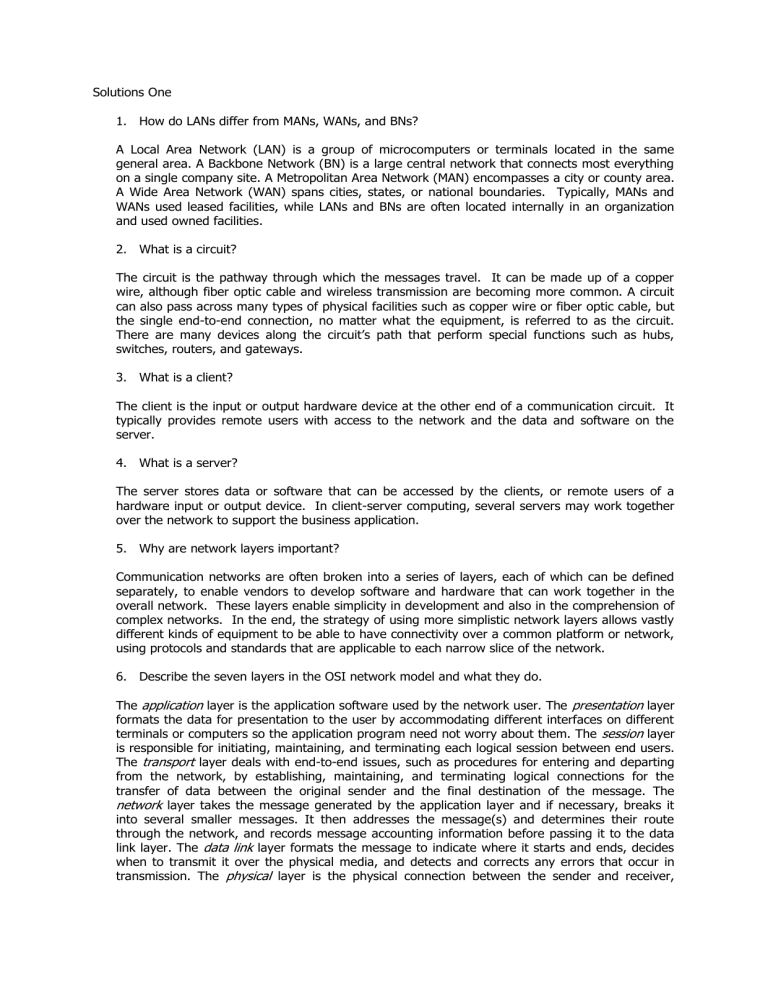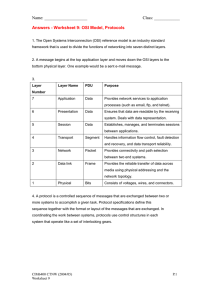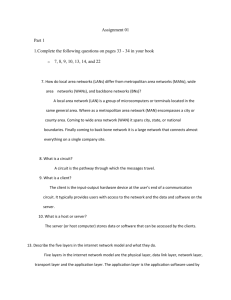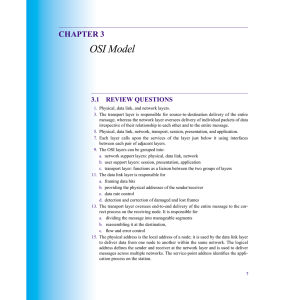Answers 1
advertisement

Solutions One 1. How do LANs differ from MANs, WANs, and BNs? A Local Area Network (LAN) is a group of microcomputers or terminals located in the same general area. A Backbone Network (BN) is a large central network that connects most everything on a single company site. A Metropolitan Area Network (MAN) encompasses a city or county area. A Wide Area Network (WAN) spans cities, states, or national boundaries. Typically, MANs and WANs used leased facilities, while LANs and BNs are often located internally in an organization and used owned facilities. 2. What is a circuit? The circuit is the pathway through which the messages travel. It can be made up of a copper wire, although fiber optic cable and wireless transmission are becoming more common. A circuit can also pass across many types of physical facilities such as copper wire or fiber optic cable, but the single end-to-end connection, no matter what the equipment, is referred to as the circuit. There are many devices along the circuit’s path that perform special functions such as hubs, switches, routers, and gateways. 3. What is a client? The client is the input or output hardware device at the other end of a communication circuit. It typically provides remote users with access to the network and the data and software on the server. 4. What is a server? The server stores data or software that can be accessed by the clients, or remote users of a hardware input or output device. In client-server computing, several servers may work together over the network to support the business application. 5. Why are network layers important? Communication networks are often broken into a series of layers, each of which can be defined separately, to enable vendors to develop software and hardware that can work together in the overall network. These layers enable simplicity in development and also in the comprehension of complex networks. In the end, the strategy of using more simplistic network layers allows vastly different kinds of equipment to be able to have connectivity over a common platform or network, using protocols and standards that are applicable to each narrow slice of the network. 6. Describe the seven layers in the OSI network model and what they do. The application layer is the application software used by the network user. The presentation layer formats the data for presentation to the user by accommodating different interfaces on different terminals or computers so the application program need not worry about them. The session layer is responsible for initiating, maintaining, and terminating each logical session between end users. The transport layer deals with end-to-end issues, such as procedures for entering and departing from the network, by establishing, maintaining, and terminating logical connections for the transfer of data between the original sender and the final destination of the message. The network layer takes the message generated by the application layer and if necessary, breaks it into several smaller messages. It then addresses the message(s) and determines their route through the network, and records message accounting information before passing it to the data link layer. The data link layer formats the message to indicate where it starts and ends, decides when to transmit it over the physical media, and detects and corrects any errors that occur in transmission. The physical layer is the physical connection between the sender and receiver, including the hardware devices (e.g., computers, terminals, and modems) and physical media (e.g., cables, and satellites). 7. Describe the five layers in the Internet network model and what they do. The application layer is the application software used by the network user. The transport layer deals with end-to-end issues, such as procedures for entering and departing from the network, by establishing, maintaining, and terminating logical connections for the transfer of data between the original sender and the final destination of the message. The network layer takes the message generated by the application layer and if necessary, breaks it into several smaller messages. It then addresses the message(s) and determines their route through the network, and records message accounting information before passing it to the data link layer. The data link layer formats the message to indicate where it starts and ends, decides when to transmit it over the physical media, and detects and corrects any errors that occur in transmission. The physical layer is the physical connection between the sender and receiver, including the hardware devices (e.g., computers, terminals, and modems) and physical media (e.g., cables, and satellites). 8. Explain how a message is transmitted from one computer to another using layers. The application layer is the application software used by the network user. The transport layer is responsible for obtaining the address of the end user (if needed), breaking a large data transmission into smaller packets (if needed), ensuring that all the packets have been received, eliminating duplicate packets, and performing flow control to ensure that no computer is overwhelmed by the number of messages it receives. The network layer takes the message generated by the application layer and if necessary, breaks it into several smaller messages. It then addresses the message(s) and determines their route through the network, and records message accounting information before passing it to the data link layer. The data link layer formats the message to indicate where it starts and ends, decides when to transmit it over the physical media, and detects and corrects any errors that occur in transmission. The physical layer is the physical connection between the sender and receiver, including the hardware devices (e.g., computers, terminals, and modems) and physical media (e.g., cables, and satellites). 9. Discuss three trends in communications and networking. First, pervasive networking will change how and where we work and with whom we do business. Pervasive networking means that we will have high speed communications networks everywhere, and that virtually any device will be able to communicate with any other device in the world. Prices for these networks will drop and the globalization of world economies will continue to accelerate. Second, the integration of voice, video, and data onto the same networks will greatly simplify networks and enable anyone to access any media at any point. Third, the rise in these pervasive, integrated networks will mean a significant increase the availability of information and new information services. It is likely that application service providers will evolve that act as information utilities. 10. Why has the Internet model replaced the OSI model? The Internet model is simpler (effectively collapsing the top three layers of the OSI model into a single model) and easier to remember and understand. Further, the ISO OSI Reference Model is the result of a formal standardization process and is technical in its presentation. By contrast, the Internet model is appropriate for those within the networking community with practical needs related to implementing the Internet and networking. However, only a few years ago the Internet model was commonly understood to have only four layers. Today, the transport layer is now separately identified in the Internet model, yielding an important, fifth layer for comprehension. This evolution in presentation may show that at least one technical distinction from the OSI model is now considered practical as the scope, volume of traffic, and complexity of networking (and of the Internet) grows.




